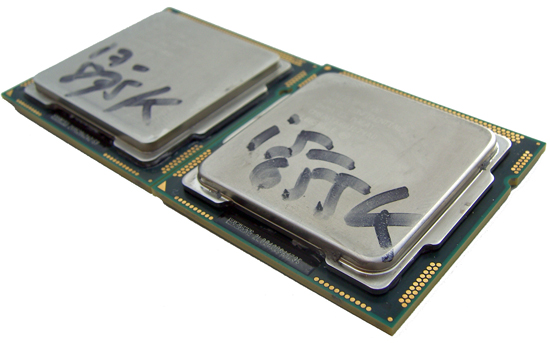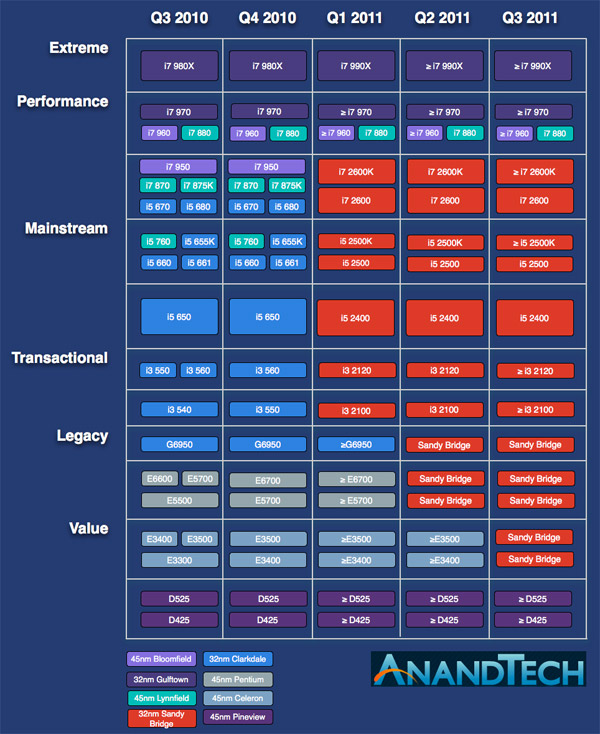Intel's Sandy Bridge Architecture Exposed
by Anand Lal Shimpi on September 14, 2010 4:10 AM EST- Posted in
- CPUs
- Intel
- Sandy Bridge
Multiplier-only Overclocking
There's no new information on Sandy Bridge overclocking at this point (although it's looking increasingly likely that there will be a reasonably priced K-series SKU for those users who want the flexibility to overclock without spending $1000). I've included the overclocking text and roadmap from our Sandy Bridge Preview below if you're interested in seeing what Intel has planned.
It wasn’t until the Pentium II that Intel started shipping multiplier locked CPUs. Before then you could set the multiplier on your CPU to anything that was supported by the line, and if you had a good chip and good enough cooling you just overclocked your processor. Intel’s policies changed once remarking, the process of relabeling and reselling a lower spec CPU as a higher one, started to take off.
While multipliers were locked, Intel left FSB overclocking open. That would be an end user or system integrator decision and not something that could be done when selling an individual CPU. However, ever since before the Pentium III Intel had aspirations of shipping fully locked CPUs. The power of the enthusiast community generally kept Intel from exploring such avenues, but we live in different times today.
Two things have changed Intel’s feelings on the topic. First and foremost is the advent of Turbo Boost. So long as Intel doesn’t artificially limit turbo modes, we now have the ability to run CPUs at whatever clock speed they can run at without exceeding thermal or current limits. We saw the first really exciting Turbo with Lynnfield, and Sandy Bridge is going to expand on that as well. On the flip side, Intel has used Turbo as a marketing differentiator between parts so there’s still a need to overclock.
The second major change within Intel is the willingness to directly address the enthusiast community with unlocked K-series SKUs. We saw this recently with the Core i7 875K and Core i5 655K parts that ship fully unlocked for the overclocking community.

The K-series SKUs, these will be more important with Sandy Bridge
With Sandy Bridge, Intel integrated the clock generator, usually present on the motherboard, onto the 6-series chipset die. While BCLK is adjustable on current Core iX processors, with Sandy Bridge it’s mostly locked at 100MHz. There will be some wiggle room as far as I can tell, but it’s not going to be much. Overclocking, as we know it, is dead.
Well, not exactly.
Intel makes three concessions.
First and foremost we have the K-series parts. These will be fully unlocked, supporting multipliers up to 57x. Sandy Bridge should have more attractive K SKUs than what we’ve seen to date. The Core i7 2600 and 2500 will both be available as a K-edition. The former should be priced around $562 and the latter at $205 if we go off of current pricing.
Secondly, some regular Sandy Bridge processors will have partially unlocked multipliers. The idea is that you take your highest turbo multiplier, add a few more bins on top of that, and that’ll be your maximum multiplier. It gives some overclocking headroom, but not limitless. Intel is still working out the details for how far you can go with these partially unlocked parts, but I’ve chimed in with my opinion and hopefully we’ll see something reasonable come from the company. I am hopeful that these partially unlocked parts will have enough multipliers available to make for decent overclocks.
Finally, if you focus on multiplier-only overclocking you lose the ability to increase memory bandwidth as you increase CPU clock speed. The faster your CPU, the more data it needs and thus the faster your memory subsystem needs to be in order to scale well. As a result, on P67 motherboards you’ll be able to adjust your memory ratios to support up to DDR3-2133.
Personally, I’d love nothing more than for everything to ship unlocked. The realities of Intel’s business apparently prevent that, so we’re left with something that could either be a non-issue or just horrible.
If the K-series parts are priced appropriately, which at first indication it seems they will be, then this will be a non-issue for a portion of the enthusiast market. You’ll pay the same amount for your Core i7 2500K as you would for a Core i5 750 and you’ll have the same overclocking potential.
Regardless of how they’re priced, what this is sure to hurt is the ability to buy a low end part like the Core i3 530 and overclock the crap out of it. What Intel decides to do with the available multiplier headroom on parts further down the stack is unknown at this point. If Intel wanted to, it could pick exciting parts at lower price points, give them a few more bins of overclocking headroom and compete in a more targeted way with AMD offerings at similar price points. A benevolent Intel would allow enough headroom as the parts can reliably hit with air cooling.
The potential for this to all go very wrong is there. I’m going to reserve final judgment until I get a better idea for what the Sandy Bridge family is going to look like.











62 Comments
View All Comments
beginner99 - Tuesday, September 14, 2010 - link
AMD's been taking about fusion forever but I can't get rid of the feeling that this Intel implementation will be much more "fused" than the AMD one will be. AMD barley has CPU turbo so adding a comined cpu/gpu turbo at once, maybe they can pull it off but experience makes me doubt that very much.BTW, if it takes like 3mm^2 for a super fast video encoder I ask my self, why wasn't this done before?
duploxxx - Tuesday, September 14, 2010 - link
first or not, doesn't really matter.who says AMD need's GPU turbo? If Liano really is a 400SP GPU it will knock any Intel GPU with or without turbo.
If we see the first results of Anadtech review which seems to be a GT2 part it doesn't have a chance at all.
core i5 is really castrated due to lack of HT, This is exactly where liano will fight against, with a bit less cpu power.
B3an - Tuesday, September 14, 2010 - link
Even if AMD's GPU in Liano is faster, intels GPU is finally decent and good enough for most people, but more importantly more people will care about CPU performance because most users dont play games and this GPU can more than easily handle HD video. And i'm sure SB will be faster than anything AMD has. Then throw in the AVX and i'd say Intel clearly have a better option for the vast majority of people, it just comes down to price now.B3an - Tuesday, September 14, 2010 - link
Sorry, didnt mean AVX, i meant the hardware accelerated video encoding.bitcrazed - Tuesday, September 14, 2010 - link
But it's not just about raw power - it's about power per dollar.If you've got $500 to spend on a mobo and CPU, where do you spend it? On a slower Intel platform or on a faster AMD platform?
If AMD get their pricing right, they could turn this into a no-brainer decision, greatly increasing their sales.
duploxxx - Tuesday, September 14, 2010 - link
now here comes the issue with the real fanboys:"And i'm sure SB will be faster than anything AMD has."
It's exactly price where AMD has the better option. It's people " known brand name" that keeps them at buying the same thing without knowledge... yeah lets buy a Pentium.
takeulo - Wednesday, September 15, 2010 - link
hahahahah yeah i agree AMD is the better option at all if i have the high budget i'll go for Insane i mean Intel but since im only "poor" and i cant afford it so i'll stick to AMD and my money worth itsorry for my bad english XD
MySchizoBuddy - Monday, December 20, 2010 - link
how do you know Intel GPU has reached good enough state (do you have benchmarks to support your hypothesis). they have been trying to reach this state for as long as i can remember.your good enough state might be very different that somebodies else's good enough state.
bindesh - Tuesday, September 20, 2011 - link
Your all doubts will be cleared after watching this video, and related once.http://www.youtube.com/watch?v=XqBk0uHrxII&fea...
I am having 3 AMDs and 1 Intel, Believe me with the price of AMD CPUs, i can only get a celeron in Intel. Which cannot run NFS SHIFT. Or TIme Shift. But other hand, with AMD athlon, i have completed Devil May Cry 4 with decent speed. And the laptop costs 24K, Toshiba C650, psg xxxxx18 model. It has 360 GB SSD, ATI 4200HD.
Can you get such price and performance with Intel?
Best part is that i am running it with 800MHz cpu speed, with performance much much greater than 55K intel dual core laptop of my friend.
vlado08 - Tuesday, September 14, 2010 - link
Still no word ont the 23.976 FPS play back?